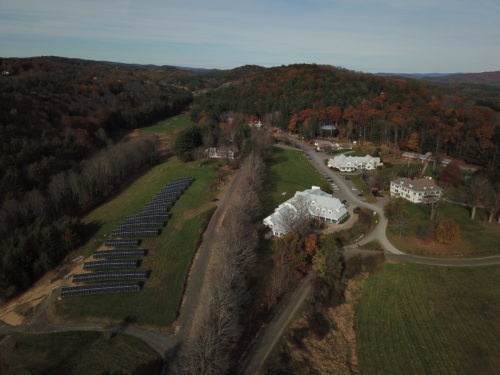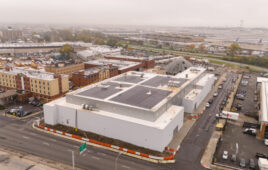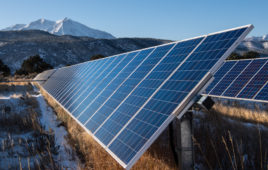Going solar is not easy for nonprofit organizations, but for the School for International Training (SIT), climate change is part of the curriculum. Not only did SIT find innovative ways to add an array, but it also committed to making the entire Brattleboro, Vermont, campus carbon-neutral.
World Learning, the parent organization of SIT, has been offering international training since 1932 to expand students’ global understanding of the world and increase their communication and leadership skills. SIT offers accredited master’s degree programs as well as undergraduate study abroad programs. The Brattleboro campus is home to around 150 World Learning and SIT employees.
In 2014, a student- and faculty-led initiative called SIT GreenUp called on the board of trustees to divest from fossil fuels, according to James Heflin, SIT’s communications and public relations specialist. After research discovered the organization was only investing a small amount into fossil fuel companies, the board opted to take a more holistic approach to sustainability. It released a “Climate Action Plan” in 2015, which included on-campus solar, bike shares, EV charging stations and more.
“This project goes a long way in helping SIT move toward our goal of becoming a greener campus,” said SIT president Sophia Howlett.
The financial equation
Solar for nonprofits is complicated. SIT couldn’t take advantage of federal rebates to help offset the cost of the system. Instead, the organization found an investor partner in clean energy investment firm Sunwealth, which could take advantage of the benefits in exchange for sharing in the cost of design, construction and operation of the new solar facility.
“Without this partnership it would have been difficult to make this project a reality, and we are hoping to take advantage of similar partnerships in the future to fulfill other energy- and cost-saving green energy initiatives,” said Paul Dery, SIT’s executive director of corporate finance.
Traditional solar financing companies typically need the collateral of bond ratings for commercial projects.
“That ignores a big chunk of middle America where the credit is perfectly good, they just don’t happen to have a bond rating,” said Jon Abe, CEO of Sunwealth.
Abe saw the World Learning center’s potential and was inspired by its mission to be carbon-neutral.
The funders decided to take it on because of those reasons—and also because they knew the engineering firm of record, Solar Design Associates, would be a stellar partner. SDA has been around since 1974, and Abe referred to the president, Steven Strong, as “the godfather of solar.”
“That’s a little bit of a stretch,” Strong replied, “but we did do the first net-metering project outside of a government laboratory in 1978.”
When the godfather is willing to take on a project, how can you say no? Sunwealth financed the project as a “one-off” deal, away from its normal funds.
“We have something that is providing a competitive return to Sunwealth’s project investors. We are also working with a partner that has a very important mission to make the world a more peaceful and sustainable and just place,” Abe said.
SIT put up a “significant amount” of capital, but not all, according to Dery. He said SIT is an investor and lender in the project, but Sunwealth owns the array. In return for SIT making the land available and investing, the organization is able to buy the power at a reduced rate.
In addition to Sunwealth’s financial backing, SIT received a grant from the Windham Regional Commission (WRC) to support renewable energy generation projects in Windham County. SIT won a $100,000 grant from the commission and used the money to help offset the project’s capital costs.
Building the project
 The 200-kWdc project was a bit of a challenge for the engineers. There wasn’t much available land on campus to install the ground-mounted array, and the spot where they were encouraged to break ground was on the crown of a hilltop—which also happened to be the single-phase portion of the campus.
The 200-kWdc project was a bit of a challenge for the engineers. There wasn’t much available land on campus to install the ground-mounted array, and the spot where they were encouraged to break ground was on the crown of a hilltop—which also happened to be the single-phase portion of the campus.
“The system size is pushing the limits of single-phase interconnection,” said Strong. “But it was certainly doable.”
Usually, college campuses have three-phase interconnections. Despite this hurdle, the utility approved the plan and SDA moved forward.
“We would have preferred to connect to a three-phase interconnection because the connection voltages could’ve been higher and the wire sizing might’ve been smaller and a little bit more economical, but it wasn’t a major issue,” said Strong.
After clinching the funding and making the location and interconnection plan, installation went smoothly. Dynamic Organics installed Silfab modules on RBI Solar racking and used SolarEdge inverters. It’s configured to accept storage if the school decides to add it later. The project is expected to save the institution approximately $10,000 in energy costs per year.
Solar studies
 Both Sunwealth and SDA were inspired by SIT’s plan to do a “stem-to-stern” energy efficiency upgrade on campus with a final goal to be carbon-neutral.
Both Sunwealth and SDA were inspired by SIT’s plan to do a “stem-to-stern” energy efficiency upgrade on campus with a final goal to be carbon-neutral.
“In the North country—this is in Vermont—you have significant climate conditioning demands which suck up a lot of energy,” Strong said.
Many learning institutions have added solar to their energy portfolios—including Kent State University in Ohio, Hampshire College in Massachusetts and Bowdoin College in Maine. But Strong said SIT is the first campus to actually take subsequent steps to become carbon neutral. It’s easier for this smaller campus as opposed to larger universities, but still a big step.
“We’ve been waiting for years to do this, and the grant made it possible,” said John Ungerleider, professor at the SIT Graduate Institute. “It’s a bright spot on campus.”
Coupling solar with other energy efficiency upgrades made the project more attractive to SDA and the installer because “that’s really where we see the future. There’s a lot of low-hanging fruit on the efficiency side and it makes every bit of solar more beneficial in terms of reaching the carbon neutrality goal,” Strong said.
 SIT is using this array as more than just an energy source. It’s implementing solar into its curriculum as well. Heflin said the solar project is linked with research, classes and a community lecture series that started last year. SIT Graduate Institute is also launching a master’s degree program focused on climate change and global sustainability. The program will prepare students for careers in policy and advocacy work, with semesters taught in Iceland and Zanzibar.
SIT is using this array as more than just an energy source. It’s implementing solar into its curriculum as well. Heflin said the solar project is linked with research, classes and a community lecture series that started last year. SIT Graduate Institute is also launching a master’s degree program focused on climate change and global sustainability. The program will prepare students for careers in policy and advocacy work, with semesters taught in Iceland and Zanzibar.
Part of the grant from the Windham Regional Commission will go toward researching whether they can grow shade crops between the rows of the solar array. The research will be done by a subcontractor who is a local agriculture researcher, but SIT and Dynamic Organics will work with her to complete the project.
Through some creative financing tools and creative engineering plans, SIT has moved one step closer to its ultimate goal of carbon neutrality.






So proud of SIT! Action, action, action! “Never doubt that a small group of thoughtful, committed citizens can change the world; indeed, it’s the only thing that ever has.” – Margaret Mead